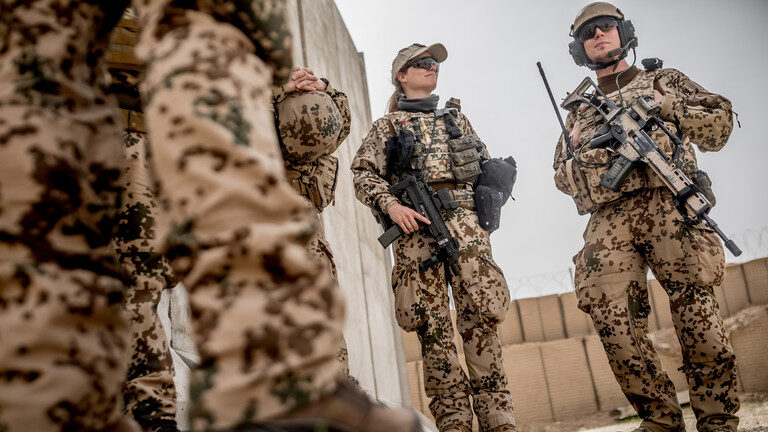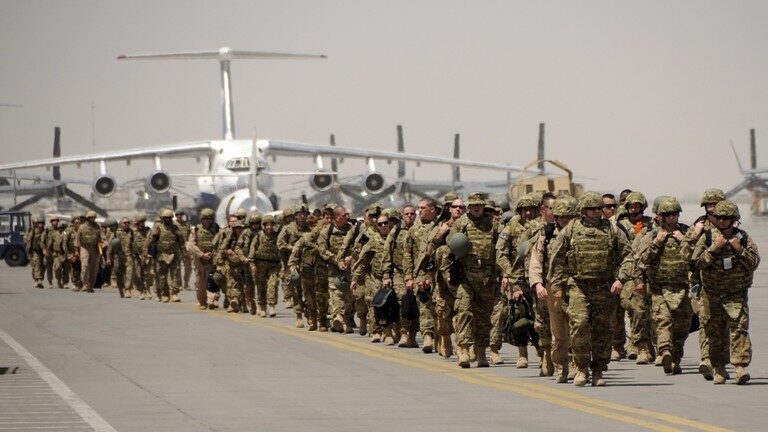The White House confirmed that the exit had begun on Thursday night, with deputy press secretary Karine Jean-Pierre telling reporters on Air Force One that "a drawdown is underway."
"Potential adversaries should know that if they attack us in our withdrawal, we will defend ourselves, [and] our partners, with all the tools at our disposal," she said, adding that the American presence would temporarily grow before a final pullout.
"While these actions will initially result in increased forces levels, we remain committed to having all US military personnel out of Afghanistan by September 11, 2021."
Multiple long-range B-52H Stratofortress bombers were made available to CENTCOM, the US military command that covers the Middle East and Central Asia, CNBC reported, while a Navy carrier strike group is also in the region to provide support if needed.
While former President Donald Trump had signed a deal with the Taliban last year that committed the US to a full withdrawal by May 1, 2021, his successor, Joe Biden, scrapped the agreement, instead pushing back the deadline to September 11. The Taliban previously vowed to resume attacks on US forces if all foreign troops were not out of the country by May, warning Washington would face "compounded problems" after Biden announced the later date earlier this month.
Beyond military involvement, the Biden administration has given itself a tall order in the country, with officials announcing a new plan to rewrite the Afghan constitution, arrange fresh elections and ink a power-sharing deal between the Taliban and the Kabul government last month. It remains to be seen what will come of the project, as months of bilateral negotiations in Qatar have made little progress in reaching a long-term peace deal between the two parties.
In Biden's first address to a joint session of Congress on Wednesday night, he decried the "forever war in Afghanistan," celebrating the planned withdrawal even while calling for an "over-the-horizon capacity" to be maintained in the region "to suppress future threats to the homeland."
Exactly what shape that "over-the-horizon capacity" will take is not yet clear, but according to a recent report in the New York Times, the Pentagon is now discussing repositioning forces to neighboring states in the event they need to redeploy, suggesting Tajikistan, Uzbekistan and Kazakhstan as candidates. Such a move is not without precedent, with many American soldiers now "commuting" to work in Somalia from foreign bases after Trump ordered a withdrawal from the African nation late last year.
Comment: Meaning the US is planning on sending some of its troops even closer to Russia's border, the rest will likely continue with chaos creation in the Middle East.
By far America's longest war, the conflict has claimed the lives of around 2,400 US soldiers, 3,800 contractors, more than 47,000 Afghan civilians, and cost American taxpayers in excess of $2 trillion, according to the Costs of War Project. Despite fighting for more than 20 years, with US troop levels swelling beyond 100,000 during President Barack Obama's 2009 "surge," the Taliban continues to control wide swathes of Afghanistan, as recent local estimates indicate the militant group holds sway over more than half of the country.
Germany conducts final training operation in Afghanistan ahead of joint military withdrawal after two decades

Having sent more than 100,000 soldiers to the Middle Eastern country throughout the last 20 years, Germany currently has about 1,100 members of its armed forces in Afghanistan, the second-largest presence of any nation, as well as hundreds of containers filled with equipment, from armored cars to munitions.
Comment: This 'equipment' has a habit of going missing: HUGE cache of weapons made in US, Israel, Turkey & Gulf states abandoned by terrorists in recently liberated area of Syria
German Defense Minister Annegret Kramp-Karrenbauer confirmed in April that the nation would withdraw from Afghanistan following the Biden administration's decision to set a deadline of September 11 for the complete removal of all US troops. "We have always said we are going in together, and we are going out together," Kramp-Karrenbauer said.
The spokesperson for the German Defense Ministry, David Helmbold, told reporters on April 21 that the country was considering July 4 as a potential date for its withdrawal, pending an examination into the challenges and consequences of the move. This would be ahead of a previously floated date of mid-August.
During Germany's time in Afghanistan, 59 of the country's soldiers died, the deadliest military intervention from the European nation since World War Two.
Alongside German forces in the region, there are around 10,000 soldiers from 36 NATO countries, which will start to be withdrawn from the organization's Resolute Support Mission in Afghanistan by May 1, aiming to have completed the drawdown within several months.




Gunfire erupted on the floor of the U.S. House of Representatives on March 1, 1954, when four Puerto Rican nationalists shot at random from the spectators’ galleries, shouting “Viva Puerto Rico libre!”—“Long live free Puerto Rico!” Five members of Congress were injured, one seriously. The surprise attack was mounted by four members of the Puerto Rican Nationalist Party—Lolita Lebrón, Rafael Cancel Miranda, Irvin Flores Rodriguez, and Andres Figueroa Cordero. At the time, the Capitol had few security protocols and the four would-be assassins easily entered the gallery armed with handguns. About 2:30 p.m., they indiscriminately opened fire onto the House Chamber, waving an unfurled Puerto Rican flag.
Representative Alvin M. Bentley (R-MI) took a bullet to the chest and was the most severely wounded. Four other representatives were also shot: Ben F. Jensen (R-IA) was shot in the back, Clifford Davis (D-TN) was hit in the leg, George Hyde Fallon (D-MD) was shot in the hip, and Kenneth A. Roberts (D-AL) was hit in the knee.
The four gunmen were tried and sentenced to more than 49 years in federal prison. Cordero, terminally ill, had his sentence commuted on humanitarian grounds by President Jimmy Carter in October 1977 and died in 1979. President Carter granted clemency for the remaining three later in 1979. Lebrón, the alleged ringleader and lone woman shooter, went on to become a revered figure among Puerto Ricans, and died in 2010. Miranda died recently on March 2, 2020. Today, bullet holes from the shooting are still visible in the House Chamber.
So if Biden or any other elected idiot wants to talk about insurrection, they need to be shown the bullet holes in the House.
I note they also forgot the Bernie Sanders supporter who targeted a Republican softball team at practice, attempting to assassinate as many Republican Congressional members as possible. How did this get memory holed so quickly?